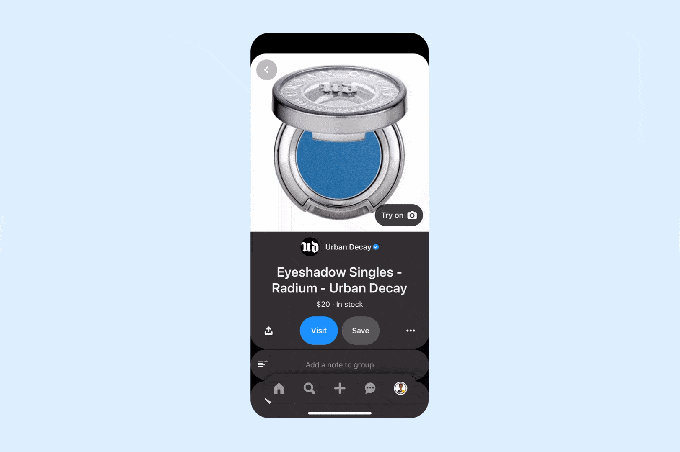Pinterest is expanding its virtual makeup try-on capabilities with today’s launch of a new augmented reality feature that allows online shoppers to virtually try on new eyeshadow. Initially, Pinterest is allowing try-on with 4,000 shades from brands like Lancome, YSL, Urban Decay and NYX Cosmetics.
The feature leverages Pinterest’s existing Lens visual search technology, its skin tone ranges feature and computer-vision-powered recommendations, the company says. We also understand Pinterest is incorporating elements from data partner ModiFace, including digitization parameters that ensure the products recognized are mapped to ModiFace’s database for higher-quality rendering.
This is not Pinterest’s first virtual makeup feature. The company had previously launched an AR try-on experience for lipstick a year ago, which has now grown to include 10,000 shades, discoverable from 48 million beauty pins from brands like Estée Lauder, bareMinerals, Neutrogena, NARS, Cle de Peau, Thrive Causemetics, NYX Professional Makeup, YSL Beauté, Lancôme and Urban Decay. Retailers, including Kohl’s, have also used AR try-on to reach consumers.
With the newly launched eyeshadow try-on, users can filter the product search results by factors like color, price range and brand. If they find something they like, they can then purchase it immediately, save it to a board, or browse a “more like this” section to find more Pins offering similar shades.

Image Credits: Pinterest
The expansion to eyeshadow means users can now experiment with more of a full makeup look, rather than just try on individual shades. There’s a toggle that lets users switch between lipstick and eyeshadow to try on multiple products at once, Pinterest says.
AR-powered virtual makeup experiences have been growing in popularity over the years, thanks in part to AR beauty apps like Perfect Corp’s YouCam Makeup, Sephora’s Virtual Artist, Ulta’s GLAMLab and others. L’Oréal has also offered Live Try-On on its website and partnered with Facebook to bring virtual makeup to the site. Target’s online Beauty Studio also offers virtual makeup.
More recently, Google entered the AR virtual makeup space, initially with the launch of a more limited feature on YouTube that allowed some beauty influencers to incorporate an AR try-on experience for products in their videos. In December 2020, however, Google more fully embraced AR try-on with the launch of virtual makeup try-on within Google Search, also in partnership with ModiFace.
But Pinterest’s expansion to eyeshadow means it’s once again ahead of Google when it comes to visual search technology and virtual makeup. Not only does it offer more lipstick shades than Google, it now also offers eyeshadow try-on.
Pinterest says the AR try-on feature is being made available for free to brands who want to create visual shopping experiences and reach customers earlier in their decision-making process. The company says it continues to generate revenue through ads, including shopping ads, and not by monetizing its AR features or doing any revenue share on the try-ons that turn into sales.
“As we make Pinterest more shoppable through products like AR Try on, the platform becomes more engaging and actionable to Pinners, which can result in increases in usage and click-through of ads,” a spokesperson explains. “Organic features like Try on and ingestion of catalogs to create product Pins can oftentimes complement a paid strategy where brands drive traffic across the site,” they noted.
The support for eyeshadow try-on is timely. Some beauty brand sales have been depressed by the pandemic, and particularly lipsticks, since it makes no sense to use lip color when your face is under a mask. Instead, current beauty trends have shifted to highlighting the eyes, with bright and bold colors for eyeshadow shades, the wild floating eyeliner look, large false lashes, and more — trends that are also designed to look good when filmed for social media posts, of course.
Pinterest says it has indications that its AR features are converting undecided shoppers to customers. In 2020, Pinterest found that users would try on an average of six lipstick shades once they began the AR try-on experience, and then were five times more likely to show purchase intent on try-on compared with standard Pins.
The new eyeshadow try-on is live starting today using the Lens camera in the Pinterest app for iOS and Android.
Correction: Perfect Corp runs YouCam makeup, not ModiFAce. We’ve updated to fix this error.

from Android – TechCrunch https://ift.tt/3pfQMAk
via
IFTTT
